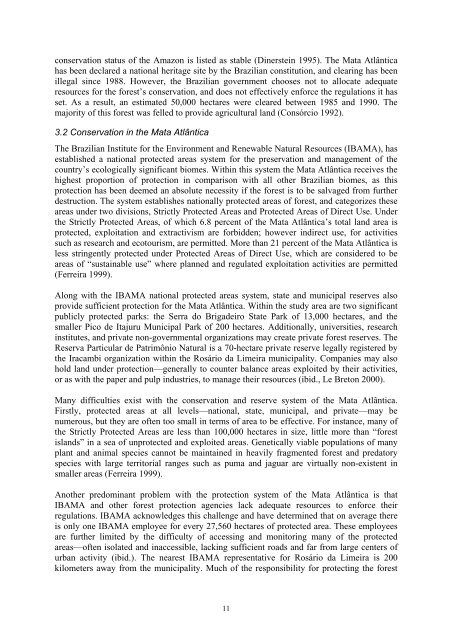Deforestation, Coffee Cultivation, and Land Degradation ... - lumes
Deforestation, Coffee Cultivation, and Land Degradation ... - lumes
Deforestation, Coffee Cultivation, and Land Degradation ... - lumes
Create successful ePaper yourself
Turn your PDF publications into a flip-book with our unique Google optimized e-Paper software.
conservation status of the Amazon is listed as stable (Dinerstein 1995). The Mata Atlânticahas been declared a national heritage site by the Brazilian constitution, <strong>and</strong> clearing has beenillegal since 1988. However, the Brazilian government chooses not to allocate adequateresources for the forest’s conservation, <strong>and</strong> does not effectively enforce the regulations it hasset. As a result, an estimated 50,000 hectares were cleared between 1985 <strong>and</strong> 1990. Themajority of this forest was felled to provide agricultural l<strong>and</strong> (Consórcio 1992).3.2 Conservation in the Mata AtlânticaThe Brazilian Institute for the Environment <strong>and</strong> Renewable Natural Resources (IBAMA), hasestablished a national protected areas system for the preservation <strong>and</strong> management of thecountry’s ecologically significant biomes. Within this system the Mata Atlântica receives thehighest proportion of protection in comparison with all other Brazilian biomes, as thisprotection has been deemed an absolute necessity if the forest is to be salvaged from furtherdestruction. The system establishes nationally protected areas of forest, <strong>and</strong> categorizes theseareas under two divisions, Strictly Protected Areas <strong>and</strong> Protected Areas of Direct Use. Underthe Strictly Protected Areas, of which 6.8 percent of the Mata Atlântica’s total l<strong>and</strong> area isprotected, exploitation <strong>and</strong> extractivism are forbidden; however indirect use, for activitiessuch as research <strong>and</strong> ecotourism, are permitted. More than 21 percent of the Mata Atlântica isless stringently protected under Protected Areas of Direct Use, which are considered to beareas of “sustainable use” where planned <strong>and</strong> regulated exploitation activities are permitted(Ferreira 1999).Along with the IBAMA national protected areas system, state <strong>and</strong> municipal reserves alsoprovide sufficient protection for the Mata Atlântica. Within the study area are two significantpublicly protected parks: the Serra do Brigadeiro State Park of 13,000 hectares, <strong>and</strong> thesmaller Pico de Itajuru Municipal Park of 200 hectares. Additionally, universities, researchinstitutes, <strong>and</strong> private non-governmental organizations may create private forest reserves. TheReserva Particular de Patrimônio Natural is a 70-hectare private reserve legally registered bythe Iracambi organization within the Rosário da Limeira municipality. Companies may alsohold l<strong>and</strong> under protection—generally to counter balance areas exploited by their activities,or as with the paper <strong>and</strong> pulp industries, to manage their resources (ibid., Le Breton 2000).Many difficulties exist with the conservation <strong>and</strong> reserve system of the Mata Atlântica.Firstly, protected areas at all levels—national, state, municipal, <strong>and</strong> private—may benumerous, but they are often too small in terms of area to be effective. For instance, many ofthe Strictly Protected Areas are less than 100,000 hectares in size, little more than “forestisl<strong>and</strong>s” in a sea of unprotected <strong>and</strong> exploited areas. Genetically viable populations of manyplant <strong>and</strong> animal species cannot be maintained in heavily fragmented forest <strong>and</strong> predatoryspecies with large territorial ranges such as puma <strong>and</strong> jaguar are virtually non-existent insmaller areas (Ferreira 1999).Another predominant problem with the protection system of the Mata Atlântica is thatIBAMA <strong>and</strong> other forest protection agencies lack adequate resources to enforce theirregulations. IBAMA acknowledges this challenge <strong>and</strong> have determined that on average thereis only one IBAMA employee for every 27,560 hectares of protected area. These employeesare further limited by the difficulty of accessing <strong>and</strong> monitoring many of the protectedareas—often isolated <strong>and</strong> inaccessible, lacking sufficient roads <strong>and</strong> far from large centers ofurban activity (ibid.). The nearest IBAMA representative for Rosário da Limeira is 200kilometers away from the municipality. Much of the responsibility for protecting the forest11
















